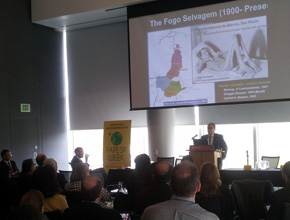

USP and UNC-Chapel Hill researchers have been studying the autoimmune condition for more than 25 years (photo: K. Toledo)
USP and UNC-Chapel Hill researchers have been studying the autoimmune condition for more than 25 years.
USP and UNC-Chapel Hill researchers have been studying the autoimmune condition for more than 25 years.

USP and UNC-Chapel Hill researchers have been studying the autoimmune condition for more than 25 years (photo: K. Toledo)
By Karina Toledo
Agência FAPESP – Through a partnership that has spanned a quarter of a century, researchers from Universidade de São Paulo (USP) and the University of North Carolina (UNC) at Chapel Hill analyzed environmental, genetic and immunological factors that led to the development of endemic pemphigus foliaceus, also known as fogo selvagem (“wildfire”).
The symptoms of this autoimmune disease include blisters all over the body that, after bursting, can serve as a gateway to infections and lead to sepsis if not properly treated.
The blisters are the result of the immune system’s attack on a protein normally found in the most superficial skin layer. This protein, known as desmoglein 1, helps to stabilize skin cell attachment. The body’s attack on its own protein is the result of deregulation of the immune system and could be attributed to any number of factors.
In addition to genetic predisposition, the USP and UNC-Chapel Hill researchers suspect that there is a relationship with constant exposure to certain types of blood-sucking insects, and particularly Phlebotomus (the vector of leishmaniasis, commonly known as the sand fly), Triatominae (the vector of Chagas disease, known as kissing bugs) and Simuliidae (the black fly).
The researchers presented part of the results of their work from the last several decades during FAPESP Week North Carolina, held this past November. Luis Diaz and Valéria Aoki, faculty members in the Dermatology Department at UNC-Chapel Hill’s School of Medicine, led the discussions.
“We have preliminary evidence that the serum of fogo selvagem patients recognizes certain proteins from the salivary glands of Phlebotomus. If this is really the case, it will be the first autoimmune disease for which we can determine the origin of the autoimmunity,” stated Diaz.
According to the researcher, the Cooperative Research Group on Fogo Selvagem began in 1985 through the initiative of FMUSP Professor Sebastião de Almeida Prado Sampaio. The NIH has funded the study for more than two decades.
In the 1980s, the group identified the antibodies responsible for the desmoglein attack and isolated the main antibody: IgG4. “We purified the IgG4 antibody from the serum of fogo selvagem patients and injected it into mice, developing an animal model to study the disease. Now, we are using new techniques and have reached 97% purity. The idea is to inject this purified antibody into mice and attempt to discover what specific portion of the molecule is attacked,” explained Diaz.
The Cooperative Research Group on Fogo Selvagem is also developing epidemiological studies to uncover possible environmental factors. The focus of the investigation is the indigenous village Terena de Limão Verde, located in Aquidauana, Mato Grosso do Sul.
“It is a region where the disease is endemic, affecting up to 3.4% of inhabitants, a very high incidence for an autoimmune condition. In other parts of the world, there are only sporadic cases,” explained Aoki.
Carriers of the disease and the population not affected by fogo selvagem have been monitored by the group for 20 years through clinical exams and serological control. During one of these studies, the researchers discovered the presence of antibodies that recognize proteins found in Phlebotomus saliva in the serum of fogo selvagem carriers.
“One of the hypotheses is that when the individual is bitten, the insect’s saliva modifies the structure of desmoglein 1, allowing exposure of part of the molecule that is normally hidden. Alternatively, perhaps the insect can inject or mimic desmoglein 1, triggering autoimmunity,” explained Aoki.
However, if all of the residents of the village are constantly exposed to bites by blood-sucking insects, why do only some of them develop the disease? One of the possibilities, according to the researcher, is the existence of a specific sequence of genes in the human leukocyte antigen (HLA) system – responsible for encoding proteins involved in the immune response – predisposing a person to develop the disease.
“During the clinical-epidemiological surveillance study, we discovered something unexpected: the serum of individuals who lived in the village and did not have the disease also had anti-desmoglein 1 antibodies. Additionally, the further away from the village we went, the lower the chance of finding anti-desmoglein 1 in the serum of individuals without the disease. This reinforces the importance of an environmental stimulus in the development of autoimmunity,” stated Aoki.
According to the researcher, the results have sparked major interest in the scientific community by improving understanding of how other autoimmune diseases, such as lupus and rheumatoid arthritis, work. “Perhaps other infirmities are influenced by environmental stimuli,” Aoki said.
Republish
The Agency FAPESP licenses news via Creative Commons (CC-BY-NC-ND) so that they can be republished free of charge and in a simple way by other digital or printed vehicles. Agência FAPESP must be credited as the source of the content being republished and the name of the reporter (if any) must be attributed. Using the HMTL button below allows compliance with these rules, detailed in Digital Republishing Policy FAPESP.





